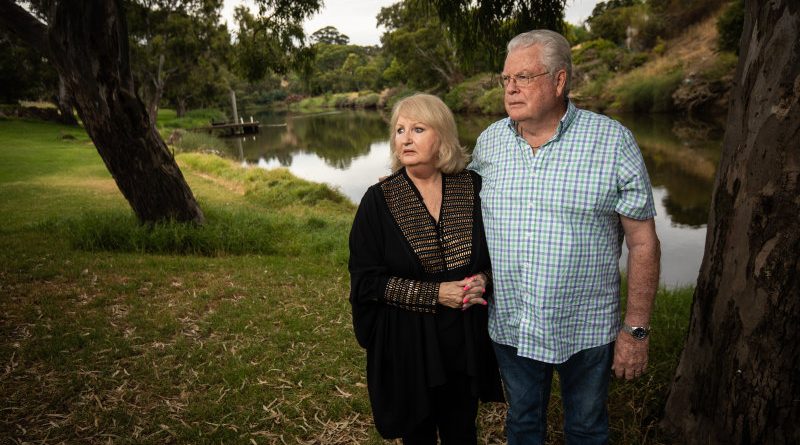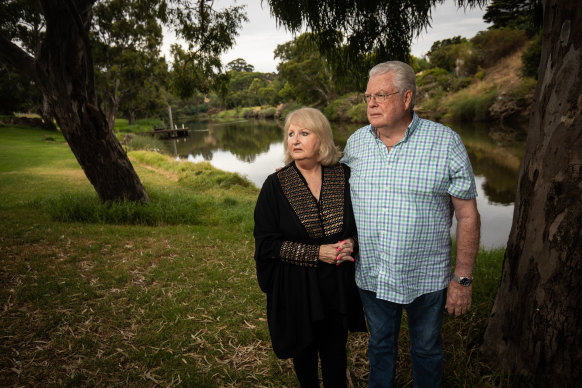How a late planning switch led to retiree homes being built on a former floodplain
Save articles for later
Add articles to your saved list and come back to them any time.
Elderly residents left homeless by the Maribyrnong River flood in October have learnt for the first time how a planning switch led to retirement village homes being built on land that was previously considered flood-prone.
Developer Tigcorp, which owns Avondale Heights retirement village Rivervue, made a submission to Melbourne Water’s flood inquiry revealing that a controversial 2016 amendment resulting in the removal of the one-in-100-year flood risk area from most of the property was originally meant to be dramatically stricter.
Rae and Colin Waters have not been able to return home since the October flood.Credit: Scott McNaughton
The 23-page document shows that the planning rules amendment requested by Melbourne Water in July 2015 initially proposed to increase the amount of designated flood-prone land over the riverside development.
However Tigcorp argued the proposal was based on outdated information because it overlooked flood mitigation earthworks it said had been undertaken with Melbourne Water’s approval.
The submission states that the water authority then agreed to reduce the size of the proposed new flood map, writing in a letter: “This will ensure that all the unit development sites are not affected by the [flood overlay].”
The change was adopted in 2016, leaving only a sliver of designated flood-prone land between the retirement village and the river.
The developer then began construction on part of the site no longer considered a floodplain. Had Melbourne Water’s original proposal stuck, homes flooded in October might never have been built.
The planning expert who backed the change as the sole person on a panel was Nick Wimbush, who was appointed chair of Melbourne Water’s flood inquiry in December. He resigned in February after revelations about the Rivervue development were published in The Age.
A new chair, former Federal and Victorian Supreme Court judge Tony Pagone, was announced on Friday.
Forty-seven top-end homes at the retirement village were damaged in the October 14 disaster, forcing residents who never expected to get flooded to pay for temporary accommodation while the residences underwent $7 million in repairs.
Tigcorp’s submission to the scandal-plagued Melbourne Water flood inquiry is one of 62 that were released on Friday on the six-month anniversary of the flood.
Melbourne Water also made a submission, but the government-owned authority has failed to complete its investigation into the development of the Rivervue retirement village.
“We will provide updated information to the Independent Review Panel as it becomes available,” the submission reads.
Rivervue resident Colin Waters, who is living in a rental property in Diggers Rest while he and wife Rae wait for their $825,000 home to be repaired, questioned Melbourne Water’s decision to agree with the developer’s request to remove the flood overlay.
The Waters, both in their 70s, said they had asked about flood risk before they signed their contract. Colin called for the site’s flood mitigation works and floor levels to be examined: “How can we feel safe in our houses?”
Tigcorp’s submission claims the document shows it obtained “all necessary design and development approvals” and that its site was developed in accordance with requirements.
Melbourne Water was contacted for comment but could not respond by deadline.
The developer’s submission points a finger at the Flemington Racecourse flood wall, saying it supports examining how it may have contributed to the October flood.
It also calls for new mitigation measures to be considered and criticises the absence of warning its village staff and residents received from Melbourne Water and the State Emergency Services before the Maribyrnong River poured into homes.
“At 7.30am village management observed that floodwaters had overwhelmed the retarding basins and was already approximately two metres away from the properties closest to the Maribyrnong River,” it reads.
“An obvious improvement that would have lessened the impact on residents would have been the operation of an effective early warning system.”
The Morning Edition newsletter is our guide to the day’s most important and interesting stories, analysis and insights. Sign up here.
Most Viewed in National
From our partners
Source: Read Full Article





